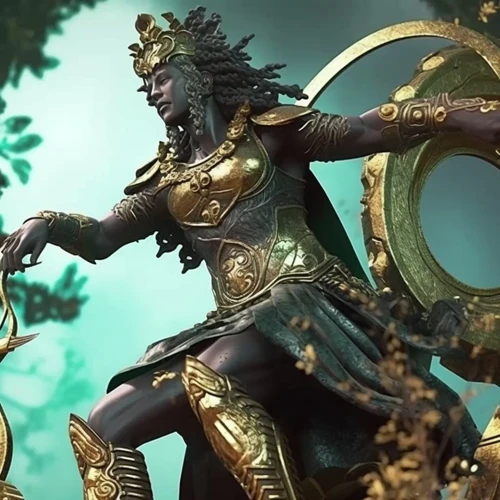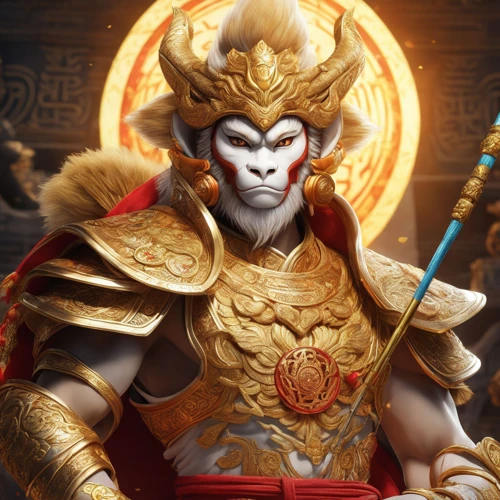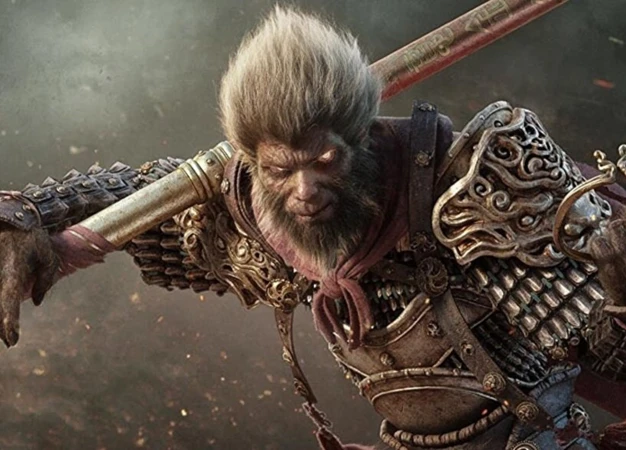With his mischievous smile and extraordinary abilities, the Monkey King has captivated audiences for centuries. Known as Sun Wukong in Chinese folklore, this legendary character is the central figure in the epic tale of Journey to the West. This ancient story, filled with adventure, supernatural beings, and moral lessons, has become a beloved part of Chinese culture and has inspired countless adaptations and references in popular culture worldwide. In this article, we will explore the origins of Sun Wukong, delve into the captivating narrative of Journey to the West, examine the fascinating characteristics and abilities of the Monkey King, and discuss the enduring popularity and influence of this timeless tale. So, buckle up and prepare to journey into the mythical world of Sun Wukong and his adventures in the legendary Journey to the West.
The Origins of Sun Wukong

Legend has it that Sun Wukong, the formidable Monkey King of Chinese mythology, was born from a stone nourished by the elements of heaven and earth. The Birth of the Stone Monkey marks the beginning of his extraordinary journey. According to the tale, after the stone had absorbed the energies of sunlight and moonlight, it burst open, revealing a stone egg. Inside this egg, Sun Wukong was conceived, springing forth fully formed and already possessing incredible strength and agility. As he grew, the Stone Monkey honed his innate abilities, becoming an expert in martial arts and the magical arts. However, it was his relentless pursuit of knowledge and desire for immortality that set him apart from his fellow monkeys. Seeking enlightenment, Sun Wukong embarked on a journey to find a master who could teach him the secrets of immortality and wisdom. After rigorous training, the Monkey King acquired the coveted title of “Great Sage, Equal of Heaven”. But with his newfound power came a rebellious spirit, leading to his infamous defiance of the gods and deities. As punishment, Sun Wukong was banished under a mountain for five hundred years, only to be eventually released by the monk Tang Sanzang to embark on the epic pilgrimage in the renowned tale, Journey to the West.
1. The Birth of the Stone Monkey
The Birth of the Stone Monkey is a captivating chapter in the origins of Sun Wukong. The legend tells of a time when a stone, nurtured by the essence of the heavens and the earth, absorbed the energies of the sun and the moon. Eventually, the stone burst open, revealing a stone egg within. Within this egg, the Monkey King came into existence, fully formed and bursting with potential. Sun Wukong possessed incredible strength and agility from the very beginning, setting him apart from his fellow monkeys. His physical prowess, coupled with his mischievous nature, made him a force to be reckoned with. As he grew, the Stone Monkey honed his martial arts skills and delved into the magical arts, becoming a formidable warrior. But it was his insatiable thirst for knowledge and immortality that propelled him on his remarkable journey. This journey would lead him to seek out a master who could teach him the secrets of eternal life and wisdom. Little did he know that this quest would not only shape his destiny but also have far-reaching consequences for the entire realm of Chinese mythology. The Birth of the Stone Monkey is just the beginning of Sun Wukong’s awe-inspiring tale, which continues to enthrall and captivate audiences to this day. For more insight into the world of Chinese mythology, you can explore the role of dragons in Chinese mythology or uncover the tale of Houyi and Chang’e, a story of love and jealousy during the Mid-Autumn Festival. (source)
2. Enlightenment and Rebellion
After his banishment, Sun Wukong found himself trapped under a mountain for five hundred years. It was during this time that the mischievous monkey underwent a transformative experience, leading to his Enlightenment and Rebellion against the heavens. In his solitude, Sun Wukong discovered the peaceful teachings of Buddhism and achieved a higher level of spiritual understanding. His newfound wisdom instilled in him a sense of rebellion against the gods who had imprisoned him. When the opportunity presented itself, the Monkey King managed to escape his rocky confines and embarked on a quest to challenge the deities and claim his rightful place. Armed with his magical staff, the Ruyi Jingu Bang, which could change size at his command, and his incredible abilities including shape-shifting and the summoning of clouds, Sun Wukong demonstrated his prowess and fearlessness. He wreaked havoc in the heavens, defeating powerful gods and deities in battles. His rebellion was not just fueled by his desire for freedom, but also to establish himself as an equal to the celestial beings. Sun Wukong’s defiance and rebellion against the heavenly hierarchy established his reputation as both a trickster and a hero, setting the stage for his epic journey in the legendary tale of Journey to the West.
Journey to the West

The epic tale of Journey to the West takes readers on a captivating adventure filled with perilous trials and spiritual enlightenment. The Call for the Pilgrimage initiates the story, as the bodhisattva Guanyin tasks the monk Tang Sanzang with a sacred mission to retrieve Buddhist scriptures from India. Tang Sanzang, accompanied by three disciples including the mischievous Sun Wukong, sets out on this treacherous journey. Gathering of the Characters brings together a diverse group of individuals, each with their own special abilities and flaws. Alongside Sun Wukong, the Monkey King, there is Zhu Bajie, a half-human, half-pig creature known for his gluttony and strength, and Sha Wujing, a river ogre eager for redemption. As the group embarks on their pilgrimage, they face numerous trials and perils. Battling demons, overcoming obstacles, and wit moments with supernatural beings challenge the characters’ resolve and unity. Throughout their arduous journey, the teachings of Buddhism become paramount, strengthening their bond and instilling moral lessons.
1. The Call for the Pilgrimage
In the first step of their incredible journey, Journey to the West, the monk Tang Sanzang received a divine call for a perilous pilgrimage. The heavenly beings, recognizing his pure and compassionate nature, entrusted him with the sacred task of retrieving ancient Buddhist scriptures from India to bring salvation to humanity. Tang Sanzang’s mission was deemed critical in restoring spiritual harmony, but the arduous journey would be fraught with countless dangers and obstacles. Aware of the perils that awaited him, the monk knew he couldn’t embark on this treacherous expedition alone. He needed a capable and loyal protector to accompany him, and that is when fate intervened. The divine call for the pilgrimage reached the ears of Sun Wukong, who had been yearning for redemption after centuries of confinement. Eager to amend his rebellious ways, the Monkey King volunteered himself as Tang Sanzang’s faithful disciple and guardian for the journey. The heavens, recognizing the potential of their combined force, accepted this unlikely partnership. Thus, the quest to secure the sacred Buddhist scriptures began, with the monkey and the monk forging a bond of companionship and embarking on a quest that would test their physical endurance, spiritual fortitude, and unwavering determination.
2. Gathering of the Characters
In the epic Journey to the West, the gathering of characters is a pivotal moment in the story. As the call for the pilgrimage resounded across the lands, individuals from different realms and backgrounds were drawn together by the quest to retrieve the sacred Buddhist scriptures. The group consisted of the brave and determined monk Tang Sanzang, who served as the leader and spiritual guide. Joining him were three powerful and loyal disciples chosen to protect him on the perilous journey. The first, and perhaps the most famous, was Sun Wukong, the Monkey King, with his shape-shifting abilities, a magical staff capable of changing size, and the power to summon wind and fire. Another member was Zhu Bajie, a half-human, half-pig creature, known for his insatiable appetite and prowess in combat. Rounding out the group was Sha Wujing, a quiet and steadfast water spirit, often portrayed as a river ogre. Together, their skills and personalities complemented one another, forming a cohesive unit that would face numerous trials and tribulations on their quest to obtain enlightenment. Each character brought their own strengths, weaknesses, and distinct personalities to the group, creating a dynamic dynamic that was a key aspect of the story’s appeal.
3. The Perils and Trials
As part of the epic Journey to the West, the pilgrimage of Sun Wukong and his companions is fraught with peril and trials. Their quest to obtain sacred Buddhist scriptures takes them through treacherous landscapes and into encounters with formidable adversaries. Along their journey, they face various challenges that test their resolve and unity. They confront dangerous monsters, cunning demons, and malevolent spirits, each with their own unique powers and abilities. The Monkey King, with his incredible strength and magical prowess, often takes the lead in battling these adversaries, utilizing his renowned weapon, the legendary Ruyi Jingu Bang, which can change its size at will. Sun Wukong’s cunning wit and resourcefulness aid the group in overcoming numerous obstacles. From battling the fearsome Red Boy and his fiery powers to outsmarting the crafty Bull Demon King, the pilgrims face constant danger and must rely on their collective skills and the protection of their powerful Monkey King. This section of the Journey to the West showcases the resilience, bravery, and teamwork of Sun Wukong and his companions as they navigate the treacherous path towards enlightenment.
Sun Wukong: The Monkey King

Characteristics and Abilities:
1. Shape-shifting: One of Sun Wukong’s most iconic abilities is his power to shape-shift into various forms. He can transform himself into anything from a bird or an insect to a fearsome dragon or a towering giant. This shape-shifting ability allows him to adapt to different situations and outwit his opponents.
2. Immortality: As a result of consuming the mystical Peaches of Immortality, Sun Wukong possesses eternal life. This grants him an incredible advantage during his adventures, as he cannot be killed by conventional means. His immortality instills both fear and awe in those who encounter him.
3. Superhuman Strength: The Monkey King’s physical strength is unparalleled. He can effortlessly wield his magical staff, which weighs several tons, and defeat armies of foes with ease. His sheer power makes him a formidable opponent in battle, capable of toppling mountains and overpowering gods.
4. Cloud Travel: Riding on his nimbus cloud, Sun Wukong can traverse vast distances in the blink of an eye. This ability allows him and his companions to embark on their epic journey, covering incredible distances in their quest to retrieve Buddhist scriptures.
Legends and Feats:
1. The Battle for Heaven: Sun Wukong’s rebellion against the heavens is an enduring legend. Armed with his magical staff and with the aid of his trusted friends, he waged war against the celestial realm. Despite facing formidable divine opponents, including powerful deities and heavenly armies, the Monkey King’s cunning and powers proved to be a formidable challenge.
2. Defeat of the Bull Demon King: Sun Wukong’s martial prowess was put to the test when he confronted the Bull Demon King, a fearsome adversary who possessed immense strength. In a show of his skills and resourcefulness, the Monkey King not only defeated the Bull Demon King but also humbled him, demonstrating his dominance in the realm of combat.
3. Guarding the Tang Monk: Throughout their journey, Sun Wukong serves as a loyal protector to the Tang Monk, Tang Sanzang. He uses his extraordinary abilities to shield the monk from various threats, including demons, monsters, and other supernatural beings who seek to hinder their pilgrimage. His unwavering dedication showcases his loyalty and noble nature.
4. The Great Sage Equal to Heaven: Sun Wukong’s title as the “Great Sage, Equal of Heaven” signifies his ultimate achievement and recognition of his unrivaled power and wisdom. This accolade establishes him as a legendary figure whose abilities and exploits are revered and respected.
From his shape-shifting prowess to his unparalleled strength and indomitable spirit, Sun Wukong, the Monkey King, has become an icon in Chinese mythology and literature. His character continues to inspire and captivate audiences, with adaptations and references in various forms of media and popular culture, solidifying his legacy as one of the most beloved mythological figures of all time. Whether as a protector, a trickster, or a powerful warrior, the Monkey King’s enduring popularity is a testament to his timeless charm and the universal appeal of his epic tale.
Characteristics and Abilities
Sun Wukong, the legendary Monkey King, possesses a multitude of remarkable characteristics and abilities. First and foremost, his incredible strength sets him apart from others. He is capable of lifting immense weights, such as his signature weapon, the magical staff known as the Ruyi Jingu Bang, which can change its size according to his will. In addition to his physical prowess, the Monkey King is also immortal, making him virtually indestructible. His ability to transform into seventy-two different forms is another defining trait, granting him the power to become anything from animals to inanimate objects. This shape-shifting skill allows him to deceive enemies and navigate treacherous situations. Sun Wukong possesses the extraordinary ability to see through deception and illusions, making him an astute judge of character. This keen insight, combined with his mischievous nature and quick thinking, often leads him out of troublesome situations and helps him aid his companions throughout the arduous journey to the West. With his unparalleled strength, versatility, and astute mind, Sun Wukong truly stands as one of the most iconic and formidable characters in Chinese mythology.
Legends and Feats
The Monkey King, Sun Wukong, is renowned for his incredible legends and astonishing feats. His might and agility surpass those of any ordinary being. One of his most impressive abilities is his “72 Transformations,” which allow him to shape-shift into various forms, from animals to inanimate objects, with impeccable precision. This skill proves invaluable in his journey, enabling him to outwit and overcome formidable foes. The Monkey King possesses the “Golden Cudgel,” a magical staff weighing over 13,500 pounds. This powerful weapon can expand or contract at his will, making it an unstoppable force in battle. Sun Wukong’s feats go beyond physical prowess, as he also possesses immense knowledge of spells and magic. He can summon clouds to travel vast distances, extinguish fires, control the winds, and even pluck hairs from his body to transform them into clones of himself. These incredible abilities not only make Sun Wukong an irresistible force but also make him a formidable asset to his companions in their perilous journey. It is no wonder that these extraordinary legends and feats have solidified the Monkey King’s status as one of the most revered and celebrated characters in Chinese mythology.
Popularity and Influence
The enduring popularity and influence of the Monkey King and Journey to the West have reached far beyond the borders of China. The cultural significance of this epic tale has resonated with people around the world, making it one of the most well-known and beloved stories in Chinese literature. Sun Wukong, with his mischievous yet heroic nature, has become an iconic character, inspiring admiration and fascination. His journey, filled with adventure, friendship, and spiritual growth, has captured the hearts and imaginations of countless readers and viewers. Journey to the West has not only been adapted into various forms of media, including film, television, and theater, but it has also influenced other works of literature and art. The tale has even found its way into modern popular culture, with references and adaptations in video games, anime, and novels. The Monkey King’s character has also had a profound impact on the perception and understanding of Chinese mythology and folklore, showcasing the rich tapestry of Chinese storytelling and its mythical creatures and symbolism. The popularity of Sun Wukong and his epic journey continues to thrive, ensuring that the Monkey King will remain an enduring symbol of adventure and enlightenment for generations to come.
Cultural Significance
The cultural significance of the Monkey King and Journey to the West is immeasurable. This epic tale holds a special place in Chinese folklore and has had a profound impact on Chinese literature, theater, and art. It showcases important themes such as the pursuit of enlightenment, the power of friendship, and the triumph of good over evil. The character of Sun Wukong has become an iconic figure in Chinese popular culture, symbolizing bravery, wit, and rebelliousness. Additionally, the story has been interpreted as an allegory for the journey of self-discovery and spiritual cultivation, resonating with individuals of all ages and backgrounds. Journey to the West and its protagonist have also influenced other aspects of Chinese culture, such as traditional opera, martial arts, and even contemporary media. The enduring popularity of the Monkey King is evident in his presence in festivals, exhibitions, and numerous adaptations in literature, television, and film. The cultural significance of this tale serves as a testament to the enduring power and influence of Chinese mythology and storytelling heritage.
Adaptations and References
The enduring popularity of Sun Wukong and Journey to the West can be seen through the numerous adaptations and references they have inspired. In literature, the epic tale has influenced works such as “The Monkey King’s Daughter” by T.A. DeBonis and “The Forbidden Wishing Well” by Basu. Notably, the Monkey King has made appearances in popular novels like “American Gods” by Neil Gaiman and “Monkey: A Journey to the West” by David Kherdian. This beloved character has also found his way into the world of film and television. The 1970s television series “Monkey” brought the story to a Western audience, while more recent adaptations include the animated series “Monkey Magic” and the action-packed film “The Monkey King” directed by Cheang Pou-soi. Sun Wukong’s influence extends beyond the realm of literature and cinema, as he has become a beloved character in video games, including “League of Legends” and “Smite”. His iconic image has been referenced in various forms of art, from paintings and sculptures to comics and manga. The cultural significance of Sun Wukong and his adventures in Journey to the West is undeniable, bridging the gap between ancient mythology and modern creativity. This enduring influence is a testament to the timeless appeal of the Monkey King.
Conclusion
In conclusion, the legend of the Monkey King and the epic tale of Journey to the West have left an indelible mark on Chinese culture and beyond. Through the Origins of Sun Wukong, we witness the remarkable journey of a stone monkey who rises to become a deity, only to be tempered by rebellion and eventual redemption. Journey to the West takes us on a memorable pilgrimage, fraught with perils and trials, as the Monkey King and his companions embark on a quest for spiritual enlightenment. Sun Wukong, with his mischievous nature, immense strength, and magical abilities, has become an iconic character in Chinese folklore and is celebrated for his wit, bravery, and loyalty. The Monkey King’s influence is far-reaching, as seen in his numerous adaptations and references in literature, film, and art. From his portrayal in traditional Chinese operas to modern renditions in popular culture, Sun Wukong continues to inspire and captivate audiences around the world. Through the enduring popularity and cultural significance of the Monkey King, we gain a deeper appreciation for the rich tapestry of Chinese mythology and folklore, and the timeless stories that continue to resonate with audiences of all ages. So, let us continue to celebrate the legacy of Sun Wukong and the amazing world of Chinese mythology and folklore it represents.
Frequently Asked Questions
1. Who is Sun Wukong?
Sun Wukong, also known as the Monkey King, is a legendary character in Chinese mythology. He is a mischievous and powerful monkey with extraordinary abilities and a rebellious spirit.
2. What is Journey to the West?
Journey to the West is an epic Chinese novel written during the Ming Dynasty. It follows the adventures of Sun Wukong and a group of companions as they embark on a pilgrimage to retrieve Buddhist scriptures.
3. What are some of Sun Wukong’s abilities?
Sun Wukong possesses immense strength, the ability to transform into different forms, 72 transformations, and can summon clones of himself. He also has a magical staff that can shrink or grow at his command.
4. Why was Sun Wukong rebellious?
Sun Wukong’s rebellious nature stemmed from his desire for equality and his refusal to bow down to authority. He believed that he deserved the same privileges and recognition as the gods and deities.
5. What is the significance of Journey to the West in Chinese culture?
Journey to the West is considered one of the Four Great Classical Novels of Chinese literature. It has had a profound influence on Chinese culture, serving as a source of moral teachings, religious allegory, and entertainment.
6. How has Journey to the West been adapted in popular culture?
Journey to the West has inspired numerous adaptations in film, television, literature, and theater. Some notable adaptations include the TV series “Monkey” and the animated film “Monkey King: Hero Is Back.”
7. What other mythical creatures appear in Journey to the West?
Aside from Sun Wukong, Journey to the West features a variety of mythical creatures, such as the pig-like Zhu Bajie, the monk Sha Wujing, and the dragon prince-turned-horse, who all accompany the Monkey King on his pilgrimage.
8. How does Sun Wukong evolve throughout his journey?
Throughout the journey, Sun Wukong undergoes significant character development. Initially, he is impulsive and prone to causing trouble. However, as the story progresses, he learns valuable lessons about humility, loyalty, and self-sacrifice.
9. Where can I learn more about Chinese mythical creatures?
You can explore the role of dragons in Chinese mythology by reading our article on “The Role of Dragons in Chinese Mythology“.
10. Is there a connection between Sun Wukong and the Mid-Autumn Festival?
The tale of Houyi and Chang’e, a story featuring love, jealousy, and the Mid-Autumn Festival, is not directly connected to Sun Wukong and Journey to the West. However, both stories are prominent in Chinese folklore and add rich cultural context to Chinese mythology. Learn more about this captivating legend in “The Tale of Houyi and Chang’e: Love, Jealousy, and the Mid-Autumn Festival“.








